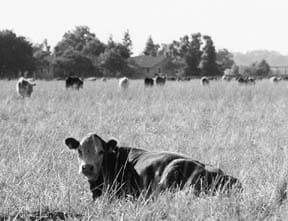by Nancy Kerns
For those of us who share our homes with companion animals, trying to understand the news about “mad cow” disease is what’s truly maddening. The newspapers and newscasters told us that a cow with bovine spongiform encephalopathy (BSE) was slaughtered and its meat distributed to food stores, but we shouldn’t worry, because the tissues that are capable of carrying the infective matter never made it into the human food chain.
But what about a pet food chain? There is no law prohibiting pet food makers from using the cattle tissues (mostly, the brain and spinal cord) that can be infected with the agent that causes BSE in cattle and can cause variant Creutzfeldt-Jakob disease (vCJD) in humans. Are our dogs vulnerable to “mad cow” disease?

According to all reputable research: No. There has never been a confirmed case of a transmissible spongiform encephalopathy (TSE) in dogs. Cats, however, can develop a form of the deadly disease, feline spongiform encephalopathy (FSE), from eating food that contains certain tissues from an infected animal. And pet food that contained infected tissue could pose a threat to humans – if they were to eat it. Don’t scoff; you’ve never known a baby or toddler who tried some of Fido’s kibble?
The Food and Drug Administration (FDA) and the United States Department of Agriculture (USDA) have put rules into place that take aim at nearly all the ways that BSE is known to pose a concern – rules that address the BSE-testing program, slaughter practices, cattle feed, and more. A risk assessment study conducted by the Harvard School of Public Health, published in 2001 (and revised in late 2003) credits the FDA and the USDA rules for reducing the risk for infectious tissues to contaminate human food to nearly zero.
However, the Harvard study also speculated that any new cases of BSE in this country would result primarily from lack of compliance with the regulations enacted to protect animal feed. Central to those rules is the 1997 FDA ban on feeding most mammalian proteins to ruminants – the practice thought to be responsible for the proliferation of BSE in Europe. Also enacted in 1997 was a rule stating that animal feeds containing mammalian proteins must carry a cautionary statement that reads “Do not feed to cattle or other ruminants.” Pet foods, however, are not required to carry the caution.
Long shot, but still…
According to some experts, the current rules don’t close every gap in human and animal safety. For example, it is theoretically (if not statistically) possible for a person to develop vCJD or a cat to develop FSE if a symptom-free but BSE-infected cow was slaughtered, its high-risk tissues (such as the brain and spinal column, which are known to contain the infectious agent) were rendered into “meat and bone meal,” which was then used in pet food, and the pet food was eaten by a human or a cat.
The scenario described above presumes the U.S. is home to cattle who are infected with BSE but are as yet undetected. While the FDA and USDA continue to insist that our meat supply is safe, the report from a subcommittee of international experts on BSE, convened by the USDA in late January 2004, speculated that BSE should now be considered to be “indigenous” to North America – a statement that the USDA does not support.
Also contained in the subcommittee’s report was the recommendation that “specified risk materials” (SRMs) – the tissues that are known to host the infectious agent that causes TSEs – be banned from all animal feed, including pet food.
So far, the FDA has not moved to ban SRMs from pet food or feed for non-ruminant animals like swine and poultry. Linda Grassie, an FDA spokeswoman, told us, “Although we will examine the International Review Subcommittee recommendations carefully, at this time we remain convinced that the many new safeguards we announced (in late January) provide the most comprehensive and scientifically justified firewalls available to protect animals and the public health against BSE.”
Feed control officials want more controls
Ben Jones, president of the Association of American Feed Control Officials (AAFCO), thinks there is ample room to strengthen the current regulations to further protect humans and animals, including cats. AAFCO is supportive of SRMs being banned from all animal feeds and requiring the caution statement on all pet foods containing prohibited proteins (the ones that can no longer be fed to ruminants), such as meat and bone meal.
“Many consumers have not keyed into the fact that the product sitting in their homes and on their shelves contains prohibited material,” Jones says. “Children sometimes consume pet foods out of their companion animals’ bowls. I saw my daughter do that, years ago when she was young. I have no evidence to support it, but I’ve heard reports that indicate certain segments of the U.S. population utilize dog food as a source of nutrition.” Cat owners, too, are also generally unaware that cats can develop FSE, and that the materials that can transmit the disease could be in the cat food, says Jones.
While the FDA was fast to recall all the meat that came from the BSE-infected cow found in Washington, experts say it would have been safe to eat, even for humans and cats. This is because the agent that causes transmissible spongiform encephalopathies is not found in the cows’ muscle tissue. Products containing prohibited materials such as “meat and bone meal” are another story, and we recommend avoiding them altogether – for your cats and your kids.






